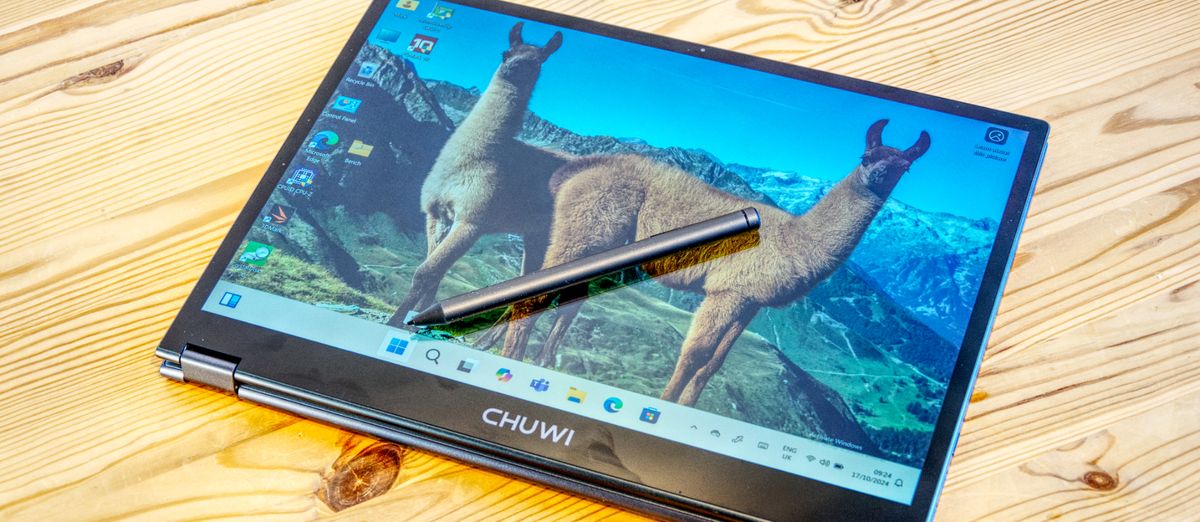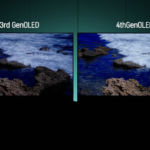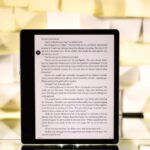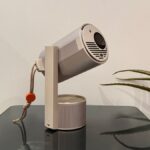Chuwi FreeBook N100: 30-second review
Chuwi is a Chinese manufacturer that first entered the market with a selection of Android tablets in 2014 before diversifying into laptops and mini PCs.
The FreeBook N100 is its latest offering. It takes a relatively low-power Intel N100 platform and places it inside an elegant 2-in-1 laptop that looks up-market with a metal skin.
Because this system can operate as both a laptop and a tablet, Chuwi makes a pressure-sensitive stylus for it, but this item isn’t included in the box with the FreeBook.
This system comes pre-installed with Windows 11 Home, and with only four cores at its disposal, the N100 struggles to maintain smooth interactions when background tasks, like updates, are occurring.
However, the biggest issue for the FreeBook N100 is the USB ports, with three included being all USB-C. The best speed offered by these is USB 3.2 Gen 1, and one requires charging. With no USB-A or HDMI on this machine, these can only be added with a hub or a dock, and without USB 3.2 Gen 2, the performance might be limited.
While the ports aren’t ideal, the screen, keyboard and touchpad are all useable, and it is relatively lightweight at just over 1.3kg.
If you expect nothing spectacular from the N100 or to complete a working day on a single charge, the FreeBook N100 is an inexpensive option for browsing and light office tasks.
Chuwi FreeBook N100: Price and availability
- How much does it cost? From $349/£267/€320
- When is it out? Available now
- Where can you get it? Direct from Chuwi
Chuwi has a direct-selling website where it sells the FreeBook and its other products, where this product can be bought. However, to confuse matters, it has separate Global, EU and US web locations, and the quoted prices are slightly different.
What’s common to all the potential sources is that the quoted price doesn’t include shipping cost, which is added at the checkout.
There is only a single SKU of the FreeBook N100 currently, and it sells for $349 on the global site. On the US site, the price is $4 more, but you can get the machine bundled with the HiPen H7 for $375.
The FreeBook can also be sourced through Amazon.com for $359.99 if you want it quickly.
Plenty of machines available through online retailers are cheaper than this and have similar CPU, memory, and storage specifications. But these are typically basic laptops without a tablet mode or a touchscreen.
One exception is the Asus BR1102FGA, an N100-powered laptop with an 11.6″ touchscreen and 2-in-1 functionality. It costs around $300, although it has only 4GB of RAM and 128GB of storage. A model for more money is available with 512GB of storage, matching the FreeBook, but that costs $350 and still only comes with 4GB of RAM.
For the specification and build quality, the Chuwi FreeBook offers excellent value for money.
Chuwi FreeBook N100: Specs
| Item | Spec |
|---|---|
| Hardware: | Chuwi FreeBook N100 |
| CPU: | Intel Celeron N100 |
| GPU: | Intel UHD Graphics for 12th-Gen Intel Processors |
| NPU: | N/A |
| RAM: | 12GB LPDDR5 |
| Storage: | 512GB M.2 NVMe SSD |
| Screen: | 13.5″ 2256 x 1504 IPS touchscreen |
| Ports: | 2x USB 3.2 Gen 1 USB-C, 1x USB 2.0 USB-C, Audio Combo Jack |
| Camera: | 720p camera |
| Networking: | Wi-Fi 6, Bluetooth 5.2 |
| Dimensions: | 301.4 x 267.35 x 17.2 mm |
| Weight: | 1.360kg |
| OS: | Windows 11 Home (pre-installed) |
| Battery: | 38Wh, 7.6V, 5000mah |
| Power supply: | 24W (12V 2A) |
Chuwi FreeBook N100: Design
- Nice build quality
- No biometrics
- Limited USB ports
Picking up the FreeBook for the first time, this machine’s weight and metallic surface are much better than the price point might infer.
This is an exceptionally clean design. The whole width of the machine is used to make the keyboard as big as possible, and the touchpad is also large and easy to operate.
Borders on the screen are narrow, and the 13-5 inch IPS panel is crisp and has good viewing angles. The natural resolution is a little odd at 2256 x 1504, but that boils down to a 3:2 ratio, which is fine for tablet use.
The reversible hinges allow the screen to be placed at any angle and the keyboard to be folded under the screen to use tablet mode. Chuwi provided one of its HiPen H7 stylus, which works well with this machine. However, there is no location on the FreeBook to mount or garage the pen when it isn’t required.
Where the FreeBook lacks the features of more expensive laptops is the biometrics department since there are no options for securing it biometrically.
It’s disappointing that they couldn’t use a power button fingerprint reader, even if an Infra Red camera with face recognition wasn’t a surprising omission.
The camera is only 720p and doesn’t include any sort of vision shield, so to block it, the owner will need to resort to a piece of tape.
More cost-cutting occurred with the USB ports, with only three included, all of which are the USB-C variety. One of these is required for charging, and the best specification is only USB 3.2 Gen 1 on two of the ports. Confusingly, the third USB-C port is only USB 2.0 and was clearly designed for a mouse. But it’s on the left side, where most users will be right-handed and want to connect it on the right.
Accepting that the Celeron N100 processor only has 9 PCIe 3.0 lanes, and four of those might have been used for the M.2 slot, that’s still enough for either all the USB to be Gen 1 ports or even Gen 2. Why this machine doesn’t have any USB-A ports is a mystery.
Perhaps part of the answer is that Chuwi makes a USB-C Hub Multiport adapter for another $25 that they’d like to sell you.
After initially being impressed with the FreeBook, by the end of our assessment, some of the features either omitted or downgraded to hit cost targets slightly undermined the overall experience.
Chuwi FreeBook N100: Hardware
- Intel Celeron N100
- UHD graphics
- Borderline Windows 11
We’ve previously discussed the Celeron N100, which is used in many laptops and tablets, like the Meenhong P8.
And, to recap what we’ve said there, with only four cores and no hyperthreading, this platform is easily overrun by the simultaneous tasks that Windows likes to run.
The point at which the owner is most likely to encounter that scenario is when they first use the machine, and Microsoft unleashes a tsunami of updates for Windows. Until this first wave of updates is complete, the machine is practically unusable, and we’d strongly recommend that you simply set it to one side until the updates are all installed.
Students using this machine need to ensure that any updates are installed before using the FreeBook for an exam. Or updates are disabled to avoid the slowdowns that downloading and installing can exhibit.
Performance isn’t a strong point for the Celeron N100, and alongside that is Intel’s least impressive GPU option, the UHD Graphics core. The GPU used in the N100 sports 24EU (execution units) first appeared in early 2022, when the Alder Lake G1 graphics processor was developed. It has 192 shader units, 12 texture mapping units, and 6 ROPs, and it has a standard clock of just 300MHz, though it can boost to 1200MHz in a pinch. Its power profile allows for a maximum draw of 15W, much more than the 6W that the N100 is rated to pull.
Compared to the Intel chips with Iris Xe and Arc GPUs, the UHD Graphics engine isn’t wonderful, mostly because it’s a 10nm chip, limiting its power efficiency.
If you are prepared to lower the resolution and detail, it can smoothly render 3D environments, but don’t expect miracles.
The flip side of the N100 and the UHD graphics is that their operation doesn’t demand much power, enabling the machine to either run for a long time on a large battery or have a smaller capacity than would be used in a Core i3 or better platform.
However, the most power-efficient options are the new Core Ultra processors and the Snapdragon X, based on our testing.
The use of Windows on this hardware negatively impacts both the user experience and power consumption. While we didn’t prove this point by making these changes to our review hardware, we suspect this equipment would run more smoothly and for longer if it ran Linux or a fork of that OS, like ChromeOS.
Windows will run on the FreeBook successfully, but the operating system assumes more hardware, processing cycles and bandwidth than it can access in this context.
Chuwi FreeBook N100: Performance
| Laptops | Header Cell – Column 1 | Chuwi FreeBook N100 | Meenhong P8 |
|---|---|---|---|
| CPU | Row 0 – Cell 1 | Intel N100 | Intel N100 |
| Cores/Threads | Row 1 – Cell 1 | 4C 4T | 4C 4T |
| TPD | Row 2 – Cell 1 | 6W | 6W |
| RAM | Row 3 – Cell 1 | 12GB LPDDR5 4800 | 12GB DDR5 4800 |
| SSD | Row 4 – Cell 1 | 500GB M.2 | 512 SATA SSD |
| Graphics | Row 5 – Cell 1 | Intel UHD Graphics 24EU | UHD Graphics 24EU |
| 3DMark | WildLife | 2,938 | 2,893 |
| Row 7 – Cell 0 | FireStrike | 1174 | 1157 |
| Row 8 – Cell 0 | TimeSpy | 372 | 365 |
| CineBench23 | Single | 855 | 810 |
| Row 10 – Cell 0 | Multi | 2863 | 1843 |
| Row 11 – Cell 0 | Ratio | 3.35 | 2.28 |
| GeekBench 5 | Single | 854 | 913 |
| Row 13 – Cell 0 | Multi | 2426 | 2208 |
| Row 14 – Cell 0 | OpenCL | 4028 | 3944 |
| Row 15 – Cell 0 | Vulkan | 4039 | 3964 |
| CrystalDIsk | Read MB/s | 3506 | 559 |
| Row 17 – Cell 0 | Write MB/s | 2087 | 507 |
| PCMark 10 | Office | 3234 | 2572 |
| Row 19 – Cell 0 | Battery | 4h 49m | 5h 51m |
| Battery Capacity | mAh | 5000 | 3200 |
| WEI | Row 21 – Cell 1 | 8 | 7.8 |
Based on the same N100 platform and with the same LPDDR5 memory model, the Chuwi Freebook N100 and the Meenhong P8 post almost identical numbers for most of these tests.
The results are remarkably close until we get to the CrystalDisk performance, where the choice of a SATA SSD rather than NVMe-connected storage delivers much more performance for the FreeBook. For users, this will make the system boot more rapidly, save documents faster, and launch apps in a shorter time.
However, there is a downside to that speed, which is that even with more battery capacity than the Meenhong P8, the battery life of the Chuwi is less. And, with little under five hours of running time from a fully charged battery, that’s an underwhelming result.
Unless some app or feature was secretly draining power, this machine cannot operate for a full working day without a recharge.
Chuwi FreeBook N100: Verdict
There are some nice things about the Chuwi FreeBook in terms of the quality of construction and finish. The screen and keyboard are both decent, and it’s reasonably lightweight.
Business users’ lack of biometric security might be an issue unless they use dongles or some form of phone sanctioning for access.
But the showstopper here is battery life, which has a short running time for such a relatively modest system. Maybe by tweaking the settings and removing some power-demanding applications, it might be possible to improve the running time, but it shouldn’t be needed.
Should you buy a Chuwi FreeBook N100?
| Value | Good build quality for the price. | 4 / 5 |
| Design | Nice exterior with the exception of the limited USB ports | 3/ 5 |
| Hardware | Modest N100 CPU and UHD GPU, but it has 12GB of RAM and 512GB of storage. | 3/ 5 |
| Performance | An NVMe SSD improves drive performance, but the battery life isn’t wonderful. | 3 / 5 |
| Overall | Affordable system for light tasks, but the battery life won?t last a working day. | 3.5 / 5 |
Buy it if…
Don’t Buy it if…
Read the full article here














